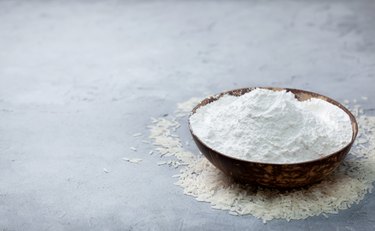
Wheat flour is a versatile cooking and baking ingredient, but unfortunately, not everyone can eat it. You can substitute rice flour for wheat flour in recipes for either cooking or baking purposes, but it's not a direct equivalent. The two grains have very different characteristics, so you'll need to be prepared for a bit of trial and error.
Kinds of Rice Flour
Video of the Day
Wheat flour contains proteins called glutenin and gliadin. When moistened and mixed, they form a stretchy web that gives doughs some elasticity. That's what gluten is at the molecular level, and an adverse immune reaction to those proteins is why many people can't eat wheat. Rice flour contains no gluten unless it's accidentally contaminated by gluten-bearing surfaces or ingredients.
Video of the Day
There are three types of rice flour. The most widely used is white rice flour, which (as the name suggests) is made by grinding regular white rice. Similarly, brown rice flour is made by milling brown rice. Like whole-wheat flour, it has a darker color and a slightly nutty flavor because it contains the grain's bran.
The third type is made with short-grain sticky rice, and it's usually described as "sweet" or "glutinous" rice flour. This doesn't mean that it tastes sweet or contains gluten (it doesn't) but rather describes the sticky, chewy, sweets-friendly texture that results from using this kind of rice. A good example is mochi. All three types of rice flour can be used in gluten-free cooking and baking.
Cooking With Rice Flour vs. Wheat Flour
The simplest place to substitute rice flour for white flour is in cooking, where gluten isn't a factor. For thickening sauces, soups and gravies, you can simply replace regular all-purpose flour with white rice flour. They're similar in their strength as thickeners and give a very comparable result. Rice flour even gives an additional advantage because the texture of the finished food won't be as affected by freezing and thawing.
The only downside to using white rice flour as a thickener is that it can have a detectably gritty or grainy texture on your tongue in some cases. Sweet rice flour is finer textured, so it's a better option for use as a general-purpose thickener if you can find it. In either case, simply whisk the rice flour with an approximately equal quantity of cold water and then stir it into your soup or sauce. You can also cook it in oil or fat to make a roux just as you would with wheat flour.
Brown rice flour is a less-common choice for thickening because it darkens sauces, but it works just as well. Some Asian foods use toasted brown rice flour as a subtle flavoring ingredient sprinkled over a dish as it's nearly completed, or it is incorporated into ground-meat mixtures as a flavoring and binding agent.
Baking With Rice Flour
How you substitute rice flour for wheat flour in baking depends on the type of baking you do and how gluten-dependent it is. In cookies, for example, where gluten is not a factor, you can simply replace all-purpose flour with rice flour and have an acceptable result. In biscuits and cakes, where some gluten is desirable, it's less effective. In breads, where gluten is ordinarily needed, you'll have to add other ingredients in order to get the right texture.
In short, for most baking, you'll need to experiment to find a blend that works well in your recipes. Many blends use white rice flour for bulk; brown rice flour, sorghum, millet or oats for flavor; and starches or gums to provide the elasticity you lose from having no gluten. If you're looking for an all-rice solution, sweet rice flour can add that elasticity.
You can use your rice flours to either create a gluten-free "all-purpose" flour or create custom blends for specific baked goods. Either way, start by comparing recipes from the internet or established cookbooks and choose one as your starting point. From there, you can add and subtract ingredients until you get the result you want.